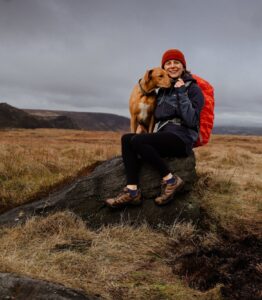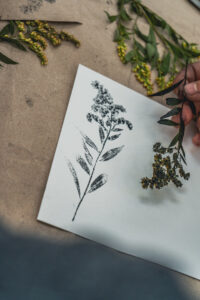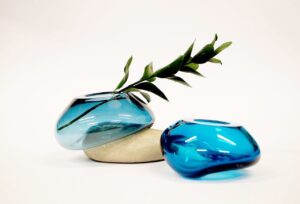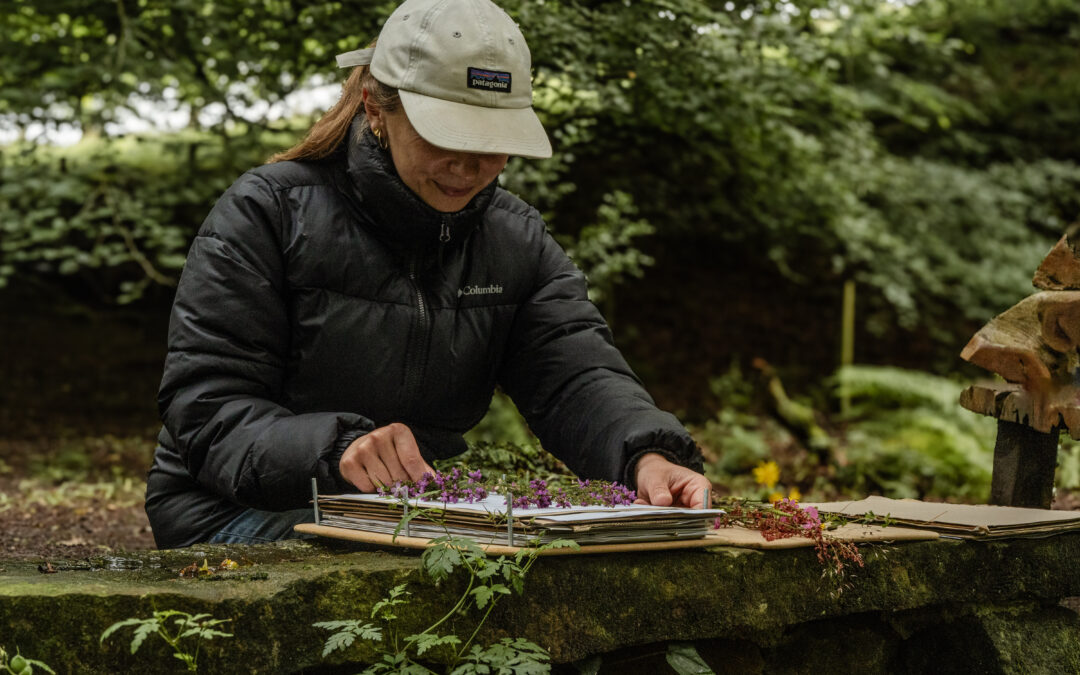Meet Amy Quinn, a Lancashire-based creative whose journey embodies the spirit of curiosity, resilience, and connection. After graduating with a first-class honours degree in Three-Dimensional Design. Amy combines her love of art, teaching, and travel to carve a path that’s uniquely her own.
honours degree in Three-Dimensional Design. Amy combines her love of art, teaching, and travel to carve a path that’s uniquely her own.
These days, you’ll find Amy living life on the road in her converted campervan alongside her giant dog Bruce. Exploring a slower and mo
re mindful way of living. Her creative practice celebrates sustainability – incorporating responsible foraging, flower pressing, printmaking, and collaging with eco-friendly materials. In order to bring the calming presence of nature into people’s spaces.
In this interview, Amy shares insights into her creative journey. The challenges and unexpected opportunities she encountered after art school, and her work today as Marketing & Awards Assistant at the Visual Artists Association (VAA).
What inspired you to pursue a career in art, and how did art school help shape your creative practice?
 I’ve always loved art – to me, art and nature are fundamental expressions of what it means to be human. My passion really began to take shape during college. Inspiring teachers and an Art Foundation course introduced me to ceramics and glass, which I absolutely fell in love with.
I’ve always loved art – to me, art and nature are fundamental expressions of what it means to be human. My passion really began to take shape during college. Inspiring teachers and an Art Foundation course introduced me to ceramics and glass, which I absolutely fell in love with.
Working at The Artroom Gallery throughout high school, college, and university gave me invaluable insight into the creative industries. Attending art buying events like the Great Northern Contemporary Craft Fair, Potfest, and The Art Market, as well as hosting exhibitions. This deepened my understanding and enthusiasm for the art world.
What’s been truly motivating is how welcoming and inspiring the people in the creative industry are – their passion fuelled my own desire to build a career in art.
How did you transition from art school to the professional world, and what were some of the biggest challenges you faced?

I graduated with a first-class honours degree and was fortunate to receive several awards, including the Display Award at Bluecoat Display Centre and participation in the GNCCF Showcase. While at university, I had already started selling my work through my website and small galleries. This helped me gain early professional experience.

After graduating, I was selected to exhibit at New Designers, which was a fantastic opportunity to showcase my work to a wider audience. My university offered an “incubator programme,” which gave me access to studio space and glass-blowing facilities at a reduced rate.
The biggest challenge was the lack of business support tailored to artists. I had to piece everything together myself by attending free courses and learning from other creatives. Looking back, I wish I’d joined a creative institution like the VAA sooner. It could have made that transition so much smoother.
Were there any unexpected opportunities or career paths that emerged after graduation?
 Yes – one exciting opportunity came when Manchester Art Gallery approached me to include my blown glass and cast concrete series, Fire & Ice, in their Nordic Craft & Design exhibition. That project was especially meaningful because it was inspired by an Icelandic road trip I took when I was 21.
Yes – one exciting opportunity came when Manchester Art Gallery approached me to include my blown glass and cast concrete series, Fire & Ice, in their Nordic Craft & Design exhibition. That project was especially meaningful because it was inspired by an Icelandic road trip I took when I was 21.
While I always wanted to work within the creative industries, I discovered a deep passion for teaching. I completed an Art & Design PGCE programme, graduating with an ‘Outstanding’ grade. Teaching has allowed me to share my love of creativity and empower others to find their own artistic voice.
How did you stay motivated and continue to develop your artistic practice after leaving art school?
I’m not going to lie – I’ve experienced burnout a couple of times over the years. Through that, I’ve realised that my art should bring me joy, and if it doesn’t, it’s okay to step back and take a break.
Right now, I’m rediscovering that joy by making art for myself again. I’ve started with small, 30-minute creative sessions in the evenings, which have been really lovely and pressure-free.
I also listen to creative podcasts like The Unpublished Podcast, We Are Makers, and How to Fail. They remind me that the creative journey is full of ups and downs – and that’s perfectly normal.
What led you to apply for a role at the VAA, and what do you enjoy most about working there?
I was really drawn to the VAA because of its core values of Freedom, Aspiration, and Creativity. These are values the team genuinely lives and breathes. When I first came across the job, I was ecstatic (and a little disappointed that I hadn’t discovered the VAA sooner for my own creative practice!).
In my role as Marketing & Awards Assistant, I have the privilege of managing key programmes like the Visual Art Open, Artist of the Year Awards, and Art500. What I enjoy most is supporting artists and helping to create meaningful opportunities that foster their growth and visibility within the arts community.
What advice would you give to recent graduates who are considering working in the arts sector?

Find a support system and understand the value of networking. It can sound intimidating, but people want to help you. Every opportunity I’ve had has come from either saying yes to something or making the first move.
Volunteering is a fantastic way to build your network and gain new skills. Last year, I started volunteering with Northern Design Festival as their marketing coordinator, which connected me with a brilliant group of creatives.
Most recently, I partnered with Patagonia Manchester to run a sustainable foraging and printmaking workshop. Just by reaching out on Instagram. You never know who will say yes until you ask.
Find a group, collective, or organisation you want to be part of. That mindset has led me to amazing opportunities, from exhibiting nationally to publishing my work and running workshops across the UK. The VAA has recently launched ArtLaunch a funded programme designed to support art students and recent graduates as they take their first steps into the professional art world – it’s a great place to find your feet as a creative who’s just starting out!
Amy’s journey is a testament to the power of curiosity, resilience, and staying true to your values. From discovering her creative voice in art school to forging a career that blends sustainability, community, and artistic expression. She shows that there is no single path to success in the arts.
Whether she’s living life on the road in her campervan, supporting artists through her work at the VAA, or reconnecting with the joy of making, Amy reminds us that creativity thrives when we give ourselves permission to explore, learn, and grow.
Her story is an inspiring example for graduates and creatives everywhere: find your people, keep asking questions, and don’t be afraid to reach out – because you never know where a simple “yes” might lead.





